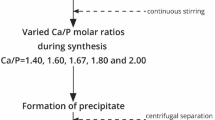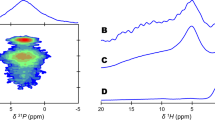Summary
The ESR spectrum of X-irradiated carbonated apatites precipitated from aqueous solutions was studied as a function of their carbonate content and drying temperature. When the latter increases from 25 to 400°C, the ESR spectrum is gradually modified and becomes similar to the spectrum of carbonated apatites, synthesized at high temperatures by solid state reactions. The latter ESR spectrum is dominated by CO 3−3 -contributions whereas the spectrum of precipitated samples dried at 25°C can mainly be interpreted in terms of CO −2 , CO −3 , and O− ions. The behavior of these earlierreported CO −2 , CO −3 , and O− centers is now studied as a function of drying temperature. In addition, the Spin Hamiltonian parameters of the CO 3−3 centers are determined and some other new paramagnetic radicals are discussed. It is shown that a CO 2−3 ion at a phosphate lattice site (B-type substitution) may give rise to either a CO −2 , CO −3 , or CO 3−3 radical on X-irradiation, depending on the sample preparation conditions. A surface CO 2−3 ion may cause a surface CO −2 , CO −3 , or O− radical. From the reported results it is not unambiguously clear whether the CO 3−3 ion detected in the samples with the relatively lowest carbonate content should be located on the surface or on a hydroxyl lattice site (A-type substitution). An important result is that the absolute concentration of the B-type CO 3−3 ion increases with increasing carbonate content as was also the case for the earlier reported B-type radicals (isotropic CO −2 and CO −3 ). On the other hand, the absolute concentration of the surface radicals decreases with increasing carbonate content. The reported results show that similar deconvolution techniques can be applied in the future for the study of ESR spectra of calcified tissues. This will allow a more efficient phenomenological investigation of the latter.
Similar content being viewed by others
References
Doi Y, Moriwaki Y, Aoba T, Okazaki M, Takahashi J, Joshin K (1982) Carbonate apatites from aqueous and nonaqueous media. Study by ESR, IR and X-ray diffraction: effect of NH +4 -ions on crystallographic parameters. J Dent Res 61(2):429–434
Callens FJ, Verbeeck RMH, Naessens DE, Matthys PFA, Boesman ER (1989) The effect of carbonate content on the ESR spectrum near g=2 of carbonated calciumapatites synthesized from aqueous media. Calcif Tissue Int 44:114–124
Cevc P, Schara M, Ravnik C (1972) Electron paramagnetic resonance study of irradiated tooth enamel. Radiation Res 51:581–589
Cevc P, Schara M, Ravnik C, Scaleric U (1976) Study of the arrangement of crystallites in gamma-irradiated human enamel by EPR. J Dent Res 55:691–695
Cevc G, Cevc P, Schara M, Scaleric U (1980) The caries resistance of human teeth is determined by the spatial arrangement of hydroxyapatite microcrystals in the enamel. Nature 286:425–426
Aoba T, Yagi T (1982) Crystallographic and structural alterations in the mineral phase of human enamel with carious attacks. J Oral Pathol 11:201–209
Martens LC, Verbeeck RMH, Matthys PFA, Driessens FCM (1984) The use of electron spin resonance of human tooth enamel in relation to caries susceptibility. J Biol Buccale 12:27–36
Martens LC, Verbeeck RMH, Callens FJ, Matthys PFA, Boesman ER, Dermaut LR (1985) Apatite crystallite alignment in sound human tooth enamel studied by ESR. J Biol Buccale 13:347–353
Martens LC, Verbeeck RMH, Callens FJ, Matthys PFA, Driessens FCM, Dermaut LR (1986) The microcrystallite alignment in human tooth enamel from carious and noncarious teeth in relation to caries susceptibility. J Biol Buccale 14:65–68
Callens FJ, Verbeeck RMH, Matthys PFA, Martens LC, Boesman ER, Driessens FCM (1986) The ESR spectrum near g=2 of carbonated calciumapatites synthesized at high temperatures. Bull Soc Chim Belg 95:589–596
Callens FJ, Verbeeck RMH, Matthys PFA, Martens LC Boesman ER (1987)13C-hyperfine couplings of carbonate radicals in carbonated calciumapatites synthesized at high temperatures. Bull Soc Chim Belg 96:165–171
Callens FJ, Verbeeck RMH, Matthys PFA, Martens LC, Boesman ER (1987) The contribution of CO 3−3 and CO −2 to the ESR spectrum near g=2 of powdered human tooth enamel. Calcif Tissue Int 41:124–129
Doi Y, Aoba T, Okazaki M, Takahashi J, Moriwaki Y (1979) Analysis of paramegnetic centers in X-ray-irradiated enamel, bone and carbonate-containing hydroxyapatite. Calcif Tissue Int 28:107–112
Doi Y, Aoba T, Okazaki M, Takahashi J, Moriwaki Y (1981)13C enriched carbonate apatites studied by ESR: comparison with human tooth enamel apatites. Calcif Tissue Int 33:81–82
Serway RA, Marshall SA (1967) Electron spin resonance absorption spectra of CO −3 and CO 3−3 molecule-ions in irradiated single-crystal calcite. J Chem Physics 46(5):1949–1952
Jaccard C (1961) Paramagnetic nitrogen oxides in irradiated potassium halides. Phys Rev 124(1):60–66
Adrian FJ, Cochran EL, Bowers VA (1969) ESR spectrum and structure of HNO −2 in KCl. J Chem Physics 51(3):1018–1025
Author information
Authors and Affiliations
Rights and permissions
About this article
Cite this article
Callens, F.J., Verbeeck, R.M.H., Naessens, D.E. et al. The effect of carbonate content and drying temperature on the ESR-spectrum near g=2 of carbonated calciumapatites synthesized from aqueous media. Calcif Tissue Int 48, 249–259 (1991). https://doi.org/10.1007/BF02556376
Received:
Revised:
Issue Date:
DOI: https://doi.org/10.1007/BF02556376




